I recently had a question from a customer asking for ideas of how to fish the nymphs they were purchasing from me. I’ve written about the variety of ways I tie on two nymphs to my leader, but I thought it might be a good time to refresh your memories. So, today’s post provides several effective methods for fishing two nymphs.
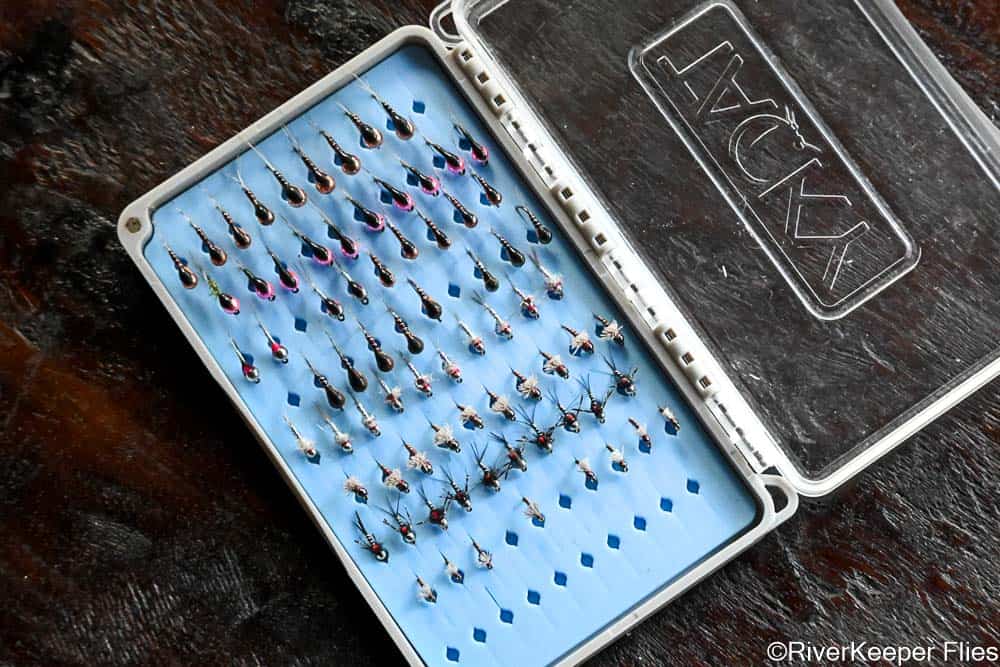
Remember, the goal when nymph fishing is to present flies, drag free, in the fish’s feeding lane. Most of the time, it means getting your fly to the bottom AND being able to feel them take the fly.
Before I start, I have to say learning to fish with multiple flies can be frustrating. Even I experience this frustration because I usually fish with one dry fly. Winter is a time I get out with plans to fish nymphs. Since I haven’t fished this way is a while, it takes practice to cast two nymphs effectively without tangling your leader and having to re-tie all your knots!
Over the many years I’ve fly fished, I have used a variety of techniques or setups when fishing two nymphs.
So find a method that works for you.
Here are a few options I’ve tried over the years.
The method I used for many years was tying a heavy nymph on the end of my dry leader and attaching an 18″ piece of leader with an improved clinch knot to the hook bend and then add a smaller nymph.
(Use a tight-line method or attach a strike indicator (bobber) like a Thingamabobber. Your fly shop will have these or something similar. Just walk in and ask.)
This method allowed me to easily change the smaller fly several times and find a nymph the fish will eat. The con is the bottom fly is lighter and there is a tendency for some slack in the line and perhaps miss a few fish that took the small nymph.
Slack line and nymph fishing are not a good combination.
Here’s what that method looks like. Look closely and you’ll see an improved clinch knot at the hook bend of the larger nymph.
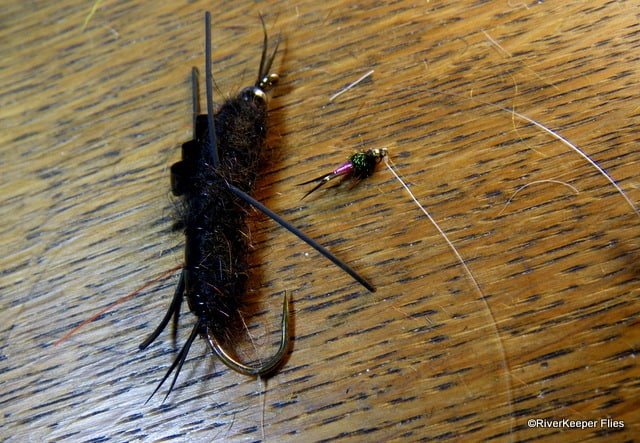
This technique worked well for me because I can remove my dry fly and quickly add a two-nymph rig.
To eliminate slack, switching the flies can work, but when fishing very small nymphs, it’s difficult to attach leader to the hook bend of a size 18 or 20 fly!
One solution is to use a tippet ring at the end of your leader. Then tie an 18″ piece of tippet with the heavier nymph to the tippet ring. Lastly, attach a 6 – 8″ piece of tippet to the tippet ring and tie on a small nymph. This method allows very little slack and you’ll be able to feel the fish much better.
The image below shows a heavier Pheasant Tail Perdigon on top with 18″ of tippet attached to the tippet ring. A Rainbow Warrior Perdigon is on the bottom tied with about 6″ of tippet material.
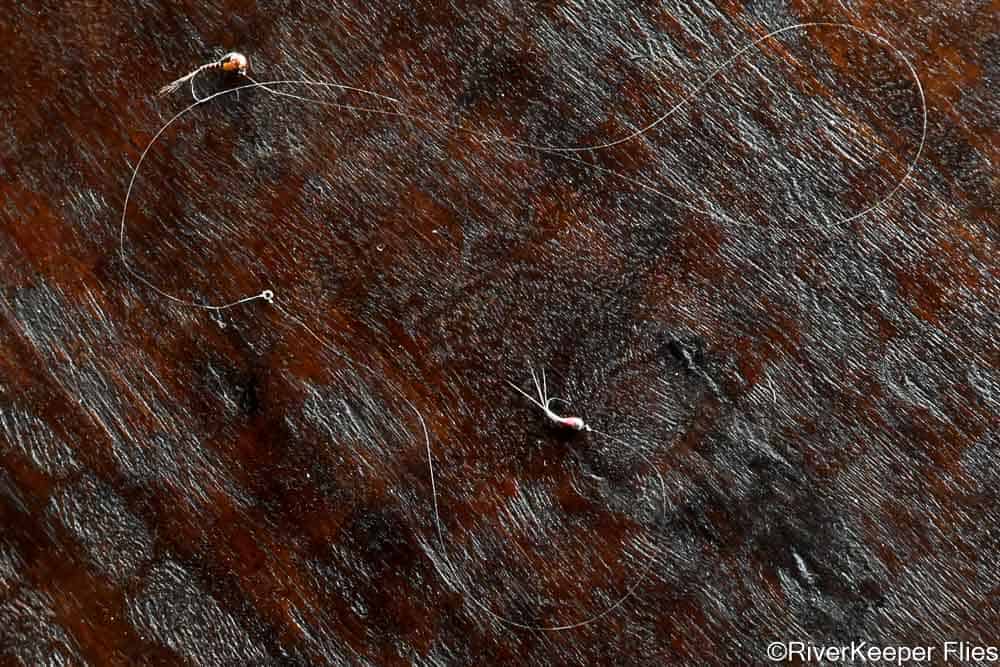
Here are the tippet rings I use.
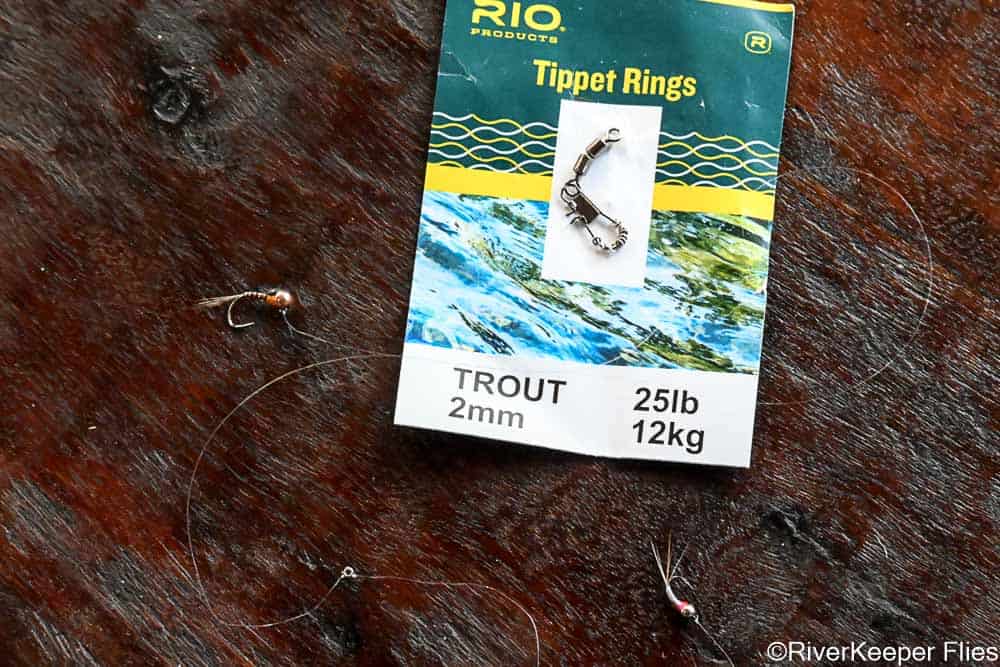
Perhaps you’ve heard of the Drop-Shot method. It’s a VERY effective method to fish multiple nymphs. I have friends that use it on the Crooked River. But I have a thing about not using split shot. I’m not saying don’t use it, I just don’t like it. Instead, I use a variety of weighted nymphs to manage getting my flies to different depths.
The Drop-Shot method works well if the main fly rod is set-up to fish nymphs…period.
Here’s how it works.
Start with tapered leader, like a Rio Indicator leader with a short orange butt. It has a long level tippet to allow faster sink rate and a heavy butt to help turn over an indicator.
- Cut off 24″ of the tippet end and immediately re-attach using a double or triple surgeon’s knot. Be sure to leave at least a 6 – 8″ tag on one end. Attach a fly to the tag.
- You should have at least 20″ of tippet remaining. Tie on your other nymph and leave 6 – 8″ tag. Tie a couple of overhand knots at the bottom and attach one or two split shots. These weights bounce along the bottom.
- If you change flies a lot, perhaps add a tippet ring when cutting off the first 24″. Use the tag or tie in another 6 – 8″ section for the first fly. Then attach the 20″ tippet like mentioned in the bullet above.
During the winter of 2019, I decided to give Euro nymphing a try. I purchased a Beula 10′ 3 weight fly rod and Rio’s Euro Nymph Fly Line.
I used the Rio Indicator leader with a short orange butt and a tippet ring and the method mentioned above with the tippet ring…tie an 18″ piece of tippet with the heavier nymph to the tippet ring and attach a 6 – 8″ piece of tippet to the tippet ring and tie on a small nymph.
The heavy perdigon or Euro nymph style fly bounces along the river bottom usually without getting snagged. Fish will eat the bottom fly or the dropper attached to the tippet ring.
The Euro style of nymphing removes the slack. I believe this style is very similar to the “high sticking” I fished many years ago. Just imagine keeping in direct contact with your flies using a tight line…well not too tight…remember, a relatively drag-free drift.
It takes practice, but is a very effective way of fishing nymphs, as you can feel the fish take your fly.
My friend Jeff Perin who owns The Fly Fisher’s Place in Sisters, OR wrote a great piece called Euro Nymphing Updates 2018 if you’d like more information about this technique. He is a great resource and I encourage you to contact him for his most recent experience.
The last technique is one I was reminded of as I watched my friend Al Beatty teach a Zoom fly tying session last week. He provided a bonus about the knot he has confidence in, the Duncan loop. Also known as the Uni knot, it looks like a simple knot to tie.
Tie a nymph on the end of your tippet. Then use the Duncan loop (or any other knot like an improved clinch knot) just above the fly using a 15 to 20″ piece of tippet. Tighten the knot and slide it just above the knot of the first fly. I’d tie a heavier nymph to the longer piece and it will bounce along the bottom while the first fly ends up being the lighter fly riding higher in the water column.
The benefit to this method is the ease of changing the first fly. Just slide the knot up the line to get it out of the way and retie a nymph. Slide the knot back in place and you’re ready to fish again! Simple, right?
Those are a few techniques for you to try. Pick one that works for you.
One thing I struggle with is how to Manage Two Nymph Rigs. It takes a while to tie all the knots whatever method you choose to use. I wrote this post for one way I’ve tried over the years.
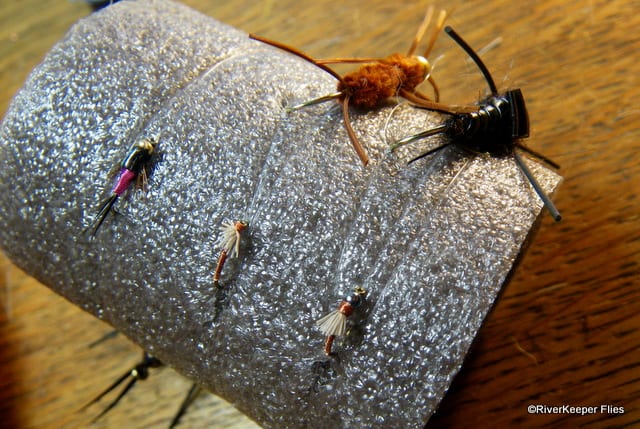
What are the benefits of this method?
- Saves time tying knots
- Eliminates wasting leader material
- Eliminates tangles in your pack or vest
- Easily change flies with only one knot
- Gets you fishing faster
Here is a list of posts I’ve written that might provide further help.
- How to Fish Unweighted Nymphs
- Experimenting with Different Nymph Rigging Techniques
- Fish a Hopper-Dropper Fly Rig
I hope this information will help you become a better nymph fly fisher.
Enjoy…go fish, stay safe!
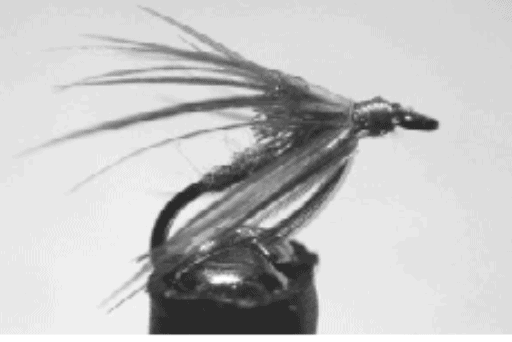

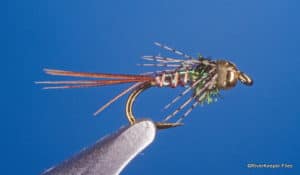
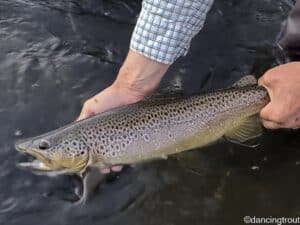
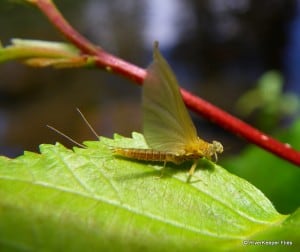


Thanks for the help gonna give it a try today tie my own flies but really like fishin the top but gonna try some lively legs this morning in a stream I fish alot in the spring we will see what happens
Thanks for the good nymphing tips, Merry
Christmas!
very informative. thanks John